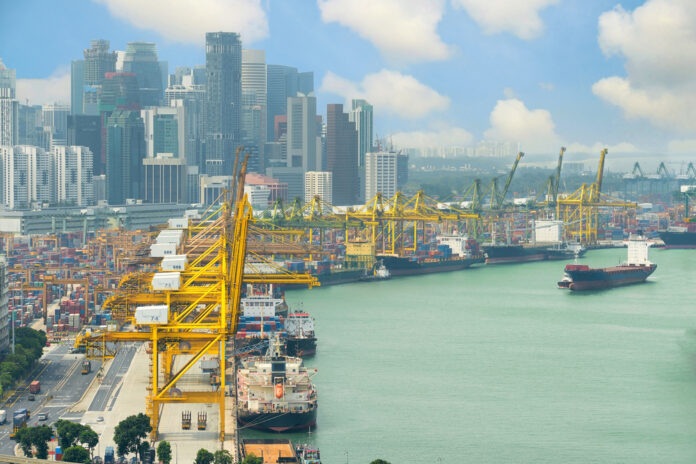On 15 May 2024, Lee Hsien Loong, Singapore’s Prime Minister for the past twenty years, will hand over the reins to his current Deputy Prime Minister, Lawrence Wong. This change in leadership is not expected to alter the highly disciplined management of monetary and fiscal policies, or the government’s economic development strategy, which is aiming, in particular, to adapt the country to climate change and to boost its potential growth. In 2024, economic activity is expected to pick up slightly, notably thanks to the improving global electronics cycle; inflationary pressures should continue to abate, but will nonetheless remain high. Against this backdrop, the authorities are expected to keep monetary policy settings unchanged this year.
A slight economic upturn
After Singapore’s activity recovered very strongly in 2021, its economic growth slowed to +3.8% in 2022 and +1.1% in 2023, mainly as a result of global demand weakening, strong inflationary pressures and tighter credit conditions. In 2023, growth in the service sector (73% of GDP) normalized following the post-COVID rebound and slowed to +2.3%. Activity in the goods producing sectors fell by -2.9%, dragged down by the contraction in the manufacturing sector (-4.3%). Activity in the construction sector remained buoyant (+5.2%), but has still not yet returned to its pre-COVID levels.
From a demand perspective, investment, stocks and goods exports were hit really hard by monetary tightening and the downturn in the global electronics cycle in 2022 and 2023. On average over 2023, stocks collapsed, and total investment stagnated (-0.2% in real terms), due to the falling investment in machinery and equipment combined with rising investment in construction and transport infrastructure. Net exports of goods and services contributed positively to real GDP growth, as a result of a stronger fall in import volumes than in export volumes over the first three quarters of the year, followed by exports bouncing back sharply in Q4. Finally, private consumption growth slowed in 2023 (to +3.8%) due to the post-COVID rebound effects fading out, inflationary pressures (which decreased over the course of the year, but were still high) and the impact of the contraction in manufacturing activity on employment and wages. As a matter of fact, the effect of disinflation on purchasing power has been offset in recent months by lower nominal wage growth. Meanwhile, the unemployment rate has remained very low (2% at the end of 2023).
Economic growth will accelerate in 2024. Domestic and external headwinds are easing, but have not vanished completely, however. Moreover, there is still a high risk of further trade and financial shocks in the current international environment. We are expecting real GDP growth of 2.2% y/y, which is relatively modest compared to the pre-COVID period.
Economic activity has started to improve in recent months, aided by the recovery in the electronics cycle in Asia. Industrial production has bounced back and goods exports have picked up, by +0.2% y/y in value terms in Q4 2023 and by +5% in Q1 2024 (after plummeting by -13% y/y over the first three quarters of 2023).
These exports are mainly made up of re-exported goods (55% of the total in 2023), non-oil local products (27% of the total, mainly made up of semiconductors) and local oil products (18%). As a matter of fact, electronics are the leading export sector of Singapore, which is also a key oil refining and trading hub.
The recovery in electronics activity seen in Q4 2023 paused into the start of 2024 (production and exports), but it is expected to pick up again quickly (and moderately), in line with the forecasts of improved global demand in this sector. This should have positive knock-on effects on the rest of the economy, stimulate investment and encourage restocking in the manufacturing sector.
In addition, Singapore is expected to continue to enjoy the gradual upturn in tourism-related activity. Over the twelve months from April 2023 to March 2024, the number of tourists travelling through Singapore Airport (62.5 million arrivals, departures or transits) was up almost 50% y/y, but was still 10% below its 2019 level.
Private consumption growth could regain momentum by the end of the year. Improving labour market conditions should follow the recovery in manufacturing activity, and inflation should continue to decline slowly. Conversely, private demand could continue to be dampened by restrictive monetary conditions.
No monetary policy easing in sight
Consumer price inflation hit record highs in the final few months of 2022 and early 2023, and has eased since. The increase in the CPI index stood at 6.1% on average in 2022, then at 4.8% in 2023 and 3% y/y in Q1 2024, compared to an annual average of 1.7% in 2010-2019. Energy price and food price inflation declined during 2023, and core inflation also eased against a backdrop of moderating wage and domestic demand growth.
However, core inflation has settled above 3% for a few months (compared to its average of 1.6% in 2010-2019). As a matter of fact, the disinflationary trend has recently been curbed by the hike in the rate of the goods and services tax (+1 pp to 9% in January), rising gas and electricity prices as a result of the hike in the carbon tax, and the new increase in international oil prices. Price hikes for some services are also expected in the very short term. Disinflation is then expected to continue in 2024, with the CPI index expected to increase by 3.1% on average over the year.
The Monetary Authority of Singapore (MAS) quickly tightened its policy in 2022 in response to rising inflation. Monetary policy settings were then kept unchanged in 2023, against a backdrop of disinflation and slowing activity. Going forward, monetary policy easing is not expected before the end of 2024 due to persisting inflationary risks. Singapore uses the exchange rate as its monetary policy instrument (and not interest rates, which is justified by the fact that the high degree of openness of the economy makes it very sensitive to imported inflation). Monetary conditions are tightened or eased through increases or decreases in the appreciation target of the nominal effective exchange rate of the Singapore dollar (SGD) and adjustments in the mid-point of its fluctuation band. Between January 2022 and March 2024, the SGD appreciated by less than 1% against the US dollar (standing at SGD 1.34 per USD in March 2024), but by nearly 10% in nominal effective terms.
Singapore’s interest rates rose rapidly in 2022 and H1 2023, before settling at a high level – as a consequence of domestic monetary policy tightening and in line with US and global interest rates. The Singapore Overnight Rate Average (SORA) rose from 0.1% in Q4 2021 to 3.7% in Q3 2023, and has not come down from this historically high level since then. Meanwhile, credit activity has contracted since 2022, affecting all economic sectors. Credit conditions are expected to remain restrictive in the short term.
The government can prioritise longer-term goals
Fiscal policy has been normalizing over the last two years. The fiscal balance, which had gone into a large deficit during the pandemic, has improved rapidly. It should return to surplus again from the 2024 fiscal year (from April 2024 to March 2025).
As a result, the government can prioritise longer-term objectives, which are as follows: i) increasing social spending (in particular, healthcare, social housing and training), in order to respond to high living costs and increasing demands of an ageing population; ii) support for digitalising the economy and developing new sectors, such as the biomedical and fintech sectors; iii) investments in infrastructure to adapt to climate change, in renewable energy (which currently plays a very small part in Singapore’s energy mix) and in low-carbon technologies.
This strategy aims both to adapt the country to climate change (Singapore is particularly vulnerable to extreme weather events and rising sea levels, with 30% of its territory located under 5 metres above sea level) and reduce its greenhouse gas emissions (with a 2050 Net Zero target), and to limit the structural slowdown in economic growth. This slowdown is mainly due to lower productivity gains and an ageing population. Economic growth is projected to stand at 2.4% per year on average over the next five years, compared to 3.2% in 2015-2019.
Singapore has strong financial and institutional capacity to cope with these challenges. From the financial standpoint, the government has very comfortable headroom for increasing its spending. Public finances are healthy, thanks to strict rules of fiscal discipline that have been followed for a long time. Government gross debt is seemingly high (171% of GDP in 2023). However, on the one hand, no debt can be incurred in order to finance recurring or operating expenses and only a limited proportion of public borrowings is used for investments (in particular, a bond issue programme was launched in 2021 to finance major infrastructure projects, including green projects). Public debt is actually mainly made up of bonds issued for the Central Provident Fund (which is filled by compulsory citizen contributions) and securities issued to be used as benchmarks on the local bond market. On the other hand, the government has very large fiscal reserves and assets, which are higher than its gross debt stock.
From the institutional and political standpoint, Singapore is highly stable and has efficient institutions, which helps with implementing a long-term economic strategy. Indeed, this strategy is not expected to be in jeopardy as a result of the upcoming change at the head of government, the first for twenty years: on 15 May 2024, Prime Minister Lee Hsien Loong will be replaced by the current Deputy Prime Minister Lawrence Wong, who has been the chosen successor since 2022 and is the leader of the “fourth generation” of the PAP (People’s Action Party, which has been in power since 1965).
Article completed on 26 April 2024.
Source link






